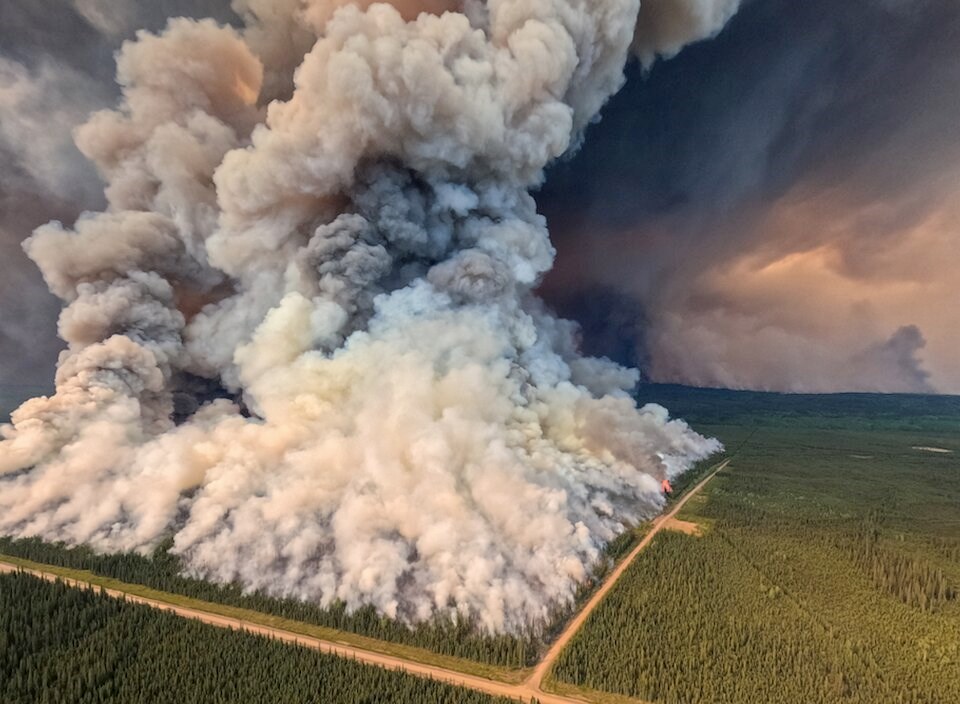The record-breaking spring temperatures that swamped British Columbia and Alberta and set the conditions for a number of powerful wildfires were made roughly 10 times more likely because of human-caused climate change, preliminary data shows.
In sa国际传媒, mean temperature anomalies ranged from more than 1.1 to 5.1 degrees Celsius above normal in May. Several weather stations with measurements going back to the 1800s measured all-time records, including Victoria Gonzales, which began in 1875, Nanaimo (1893), Kelowna (1899) and Quesnel Airport (1893), according to the BC River Forecast Centre.
Environmental and Climate Change sa国际传媒 research scientist Nathan Gillett and his colleagues have been gathering data across sa国际传媒 and Alberta to understand the footprint climate left on those May temperatures.
“Our preliminary estimate is that human-caused climate change influenced the temperatures by a factor of roughly 10,” Gillett said.
Based in Victoria, sa国际传媒, the researcher is part of a team of attribution scientists tracking climate change’s impacts on extreme events. It’s all part of a rapidly advancing field known as attribution science — one that has gained in speed and accuracy as data, modelling, and methods improve.
Gillett and his colleagues have yet to publish their findings and he warns the precise impact of climate on spring temperatures may be adjusted.
Still, he said the signal was clear and showed a “substantial impact” at the time a number of wildfires ignited and spread across the two Western Canadian provinces.
“That doesn’t surprise me,” said Karen Hodges, professor of biology who studies the impacts of fire on wildlife at the University of British Columbia’s Okanagan campus. “It's really clear that we're in anomalous terrain, that if we look back two decades, if we look back five decades, if we look back five centuries, we look back 5,000 years, what we have been experiencing in the last few years and few months, really is unusual.”
“We don't have an analogue to fall back on. Each year we're getting extremes.”
sa国际传媒’s wildfire season has already led to the scorching of nearly 4.5 million hectares of land, ranging from the country’s west coast in British Columbia to the Arctic boreal and Nova Scotia in the east.
from the fires has contaminated air across a number of east coast cities unaccustomed to the apocalyptic-like weather more common in places like Vancouver and San Francisco in recent years.
Toronto, Ottawa, Montreal and New York all faced some of the worst air quality in the world this week. The smoke from Canadian fires has even reached across the Atlantic — this week, scientists tracked plumes of fine particulate matter filling the air in .
With the summer not yet under way, many experts worry this is just the beginning of a drought and fire-filled summer.
The BC River Forecast Centre has released a warning of a “high-risk” of drought conditions across almost every corner of the province.
The report said after the hottest May on record, snowpack levels — which melt and feed streams and rivers — were 136 per cent below their levels at this time last year.
Armel Castellan, a warning preparedness meteorologist at Environment sa国际传媒, said the typical June cool and rainy period has come late and with little wind or water. The spring heat has allowed fires like the Donnie Creek wildfire — which ignited May 12 — to grow to be the second largest in the province's history.
On Friday, as a wildfire threatened the evacuated townsite of Tumbler Ridge, he said midnight westerly winds could blow the fire toward Alberta and away from the community late Friday.
Next week, Castellan says sa国际传媒 could receive a multiple-day stretch of seasonal temperatures. But the odds those low-pressure systems making up the deficit in rainfall is unlikely.
“We could take on a whole bunch of rain and it wouldn’t do much,” said Castellan.
“To even get it close to normal, we’d need to see rain every day for weeks and weeks, if not months. It’s a big ask and it’s not going to come true.”
Hodges said the conditions are priming the province for what she fears is the extension of a long and grim wildfire season.
“Fire needs three things to burn: you need ignition, you need fuel, and then you need the fire weather — you know, the conditions that will allow a fire to carry once it has started,” Hodges said. “We've got lots of fuel, all that beautiful forest is burnable. And we've got the fire weather, the extreme drought that makes that fuel available to burn.
“Add a handful of ignitions, and we are looking at more big wildfires to come.”



